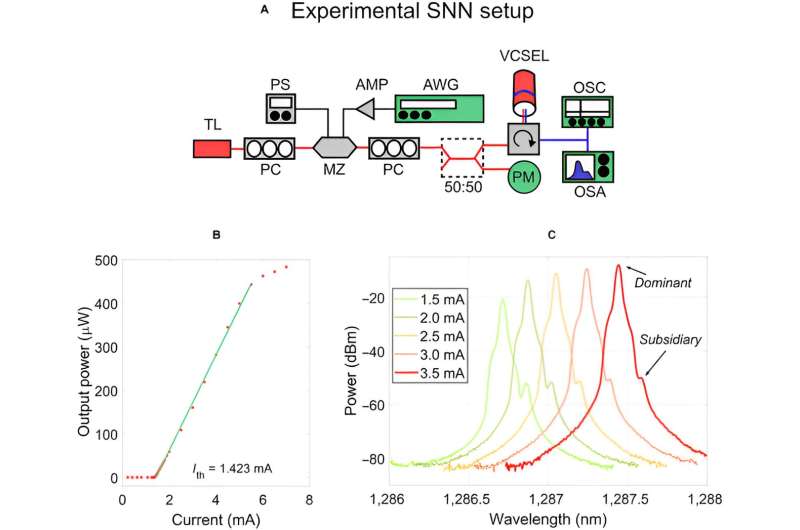This article has been reviewed according to Science X's editorial process and policies. Editors have highlighted the following attributes while ensuring the content's credibility:
fact-checked
proofread
New photonic neural networks promise ultrafast computing for complex tasks

Photonic neural network systems, which are fast and energy efficient, are especially helpful for dealing with large amounts of data. To advance photonic brain-like computing technologies, a group of researchers at the University of Strathclyde combined a spike-based neural network with a semiconductor laser that exhibits spiking neuronal behaviors.
Recently, they presented high-performance photonic spiking neural network operation with lower training requirements and introduced a novel training scheme for getting better results. This research was published in Intelligent Computing.
Neural networks, inspired by networks of biological neurons, have revolutionized artificial intelligence by providing efficient solutions to complex tasks. To further unlock their potential, researchers have been incorporating other technologies into artificial neural networks and have seen some success.
A successful example of benefits from the usage of light is that light-based or photonic neural network systems operate with faster speed and better energy efficiency, which makes them especially helpful for dealing with large amounts of data and promising for future artificial intelligence applications.
The spiking neural network proposed by the authors is based on a hardware-friendly photonic system consisting of just one vertical-cavity surface-emitting laser, a commonly available device found in mobile phones. This proposal represents an improvement on an earlier study by the same authors in which they combined reservoir computing, a powerful method for building photonic neural networks and tackling complex tasks, with a neuromorphic spiking neuron built using a laser of the same type.
In the current paper, the authors accomplished a more challenging classification task and applied an alternative training scheme to improve the speed and efficiency of training while reducing training requirements.
The classification task they tackled is a highly complex, multivariate and nonlinear problem involving 500 features per data point, and is based on the artificial dataset MADELON. To create the spiking neural network, the authors used an experimental setup that combines the nonlinear spiking dynamics of the laser with an architecture inspired by reservoir computing.
In this architecture, the input data is time-multiplexed, that is, divided into different time slots. Each time slot represents a virtual neuron in the neural network. The input data is injected into and processed by the laser, and the output is interpreted as a binary node output, either spiking or non-spiking, depending on whether the input data exceeds a certain threshold.
The authors successfully demonstrated the computational power of the photonic spiking neural network with both a traditional least-squares regression training method and their newly proposed "significance" training method. The latter assigns binary weights to nodes based on their overall usefulness and significance.
Both methods achieved excellent classification accuracies of over 94%, surpassing the benchmark performance in a fraction of the processing time. The accuracies achieved using the new method were 94.4% and 95.7%, higher than those achieved by the traditional method. The spiking neural network trained using the new method achieved outstanding performance with small training sets that had fewer than 10 data points.
In conclusion, the proposed photonic spiking neural network surpasses traditional digital semiconductor processing systems with its ultrafast performance, low power consumption, and hardware-friendly implementation that uses just one laser to process all virtual nodes. The authors believe that this study could create new possibilities for photonics-based processing systems that operate entirely on optical hardware, enabling them to tackle highly complex tasks with high accuracy, high speed, and energy-efficient operation.
More information: Dafydd Owen-Newns et al, Photonic Spiking Neural Networks with Highly Efficient Training Protocols for Ultrafast Neuromorphic Computing Systems, Intelligent Computing (2023). DOI: 10.34133/icomputing.0031
















